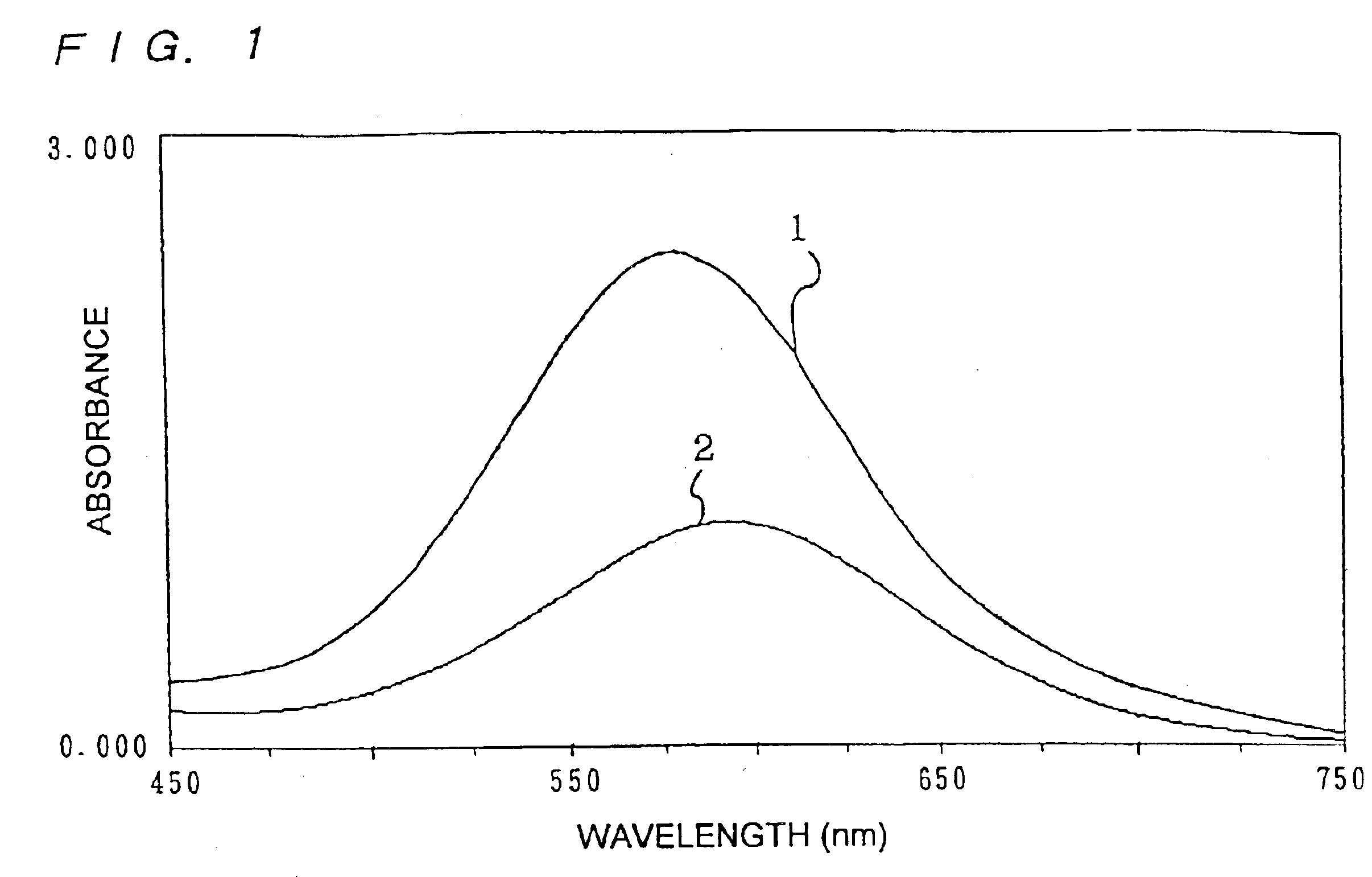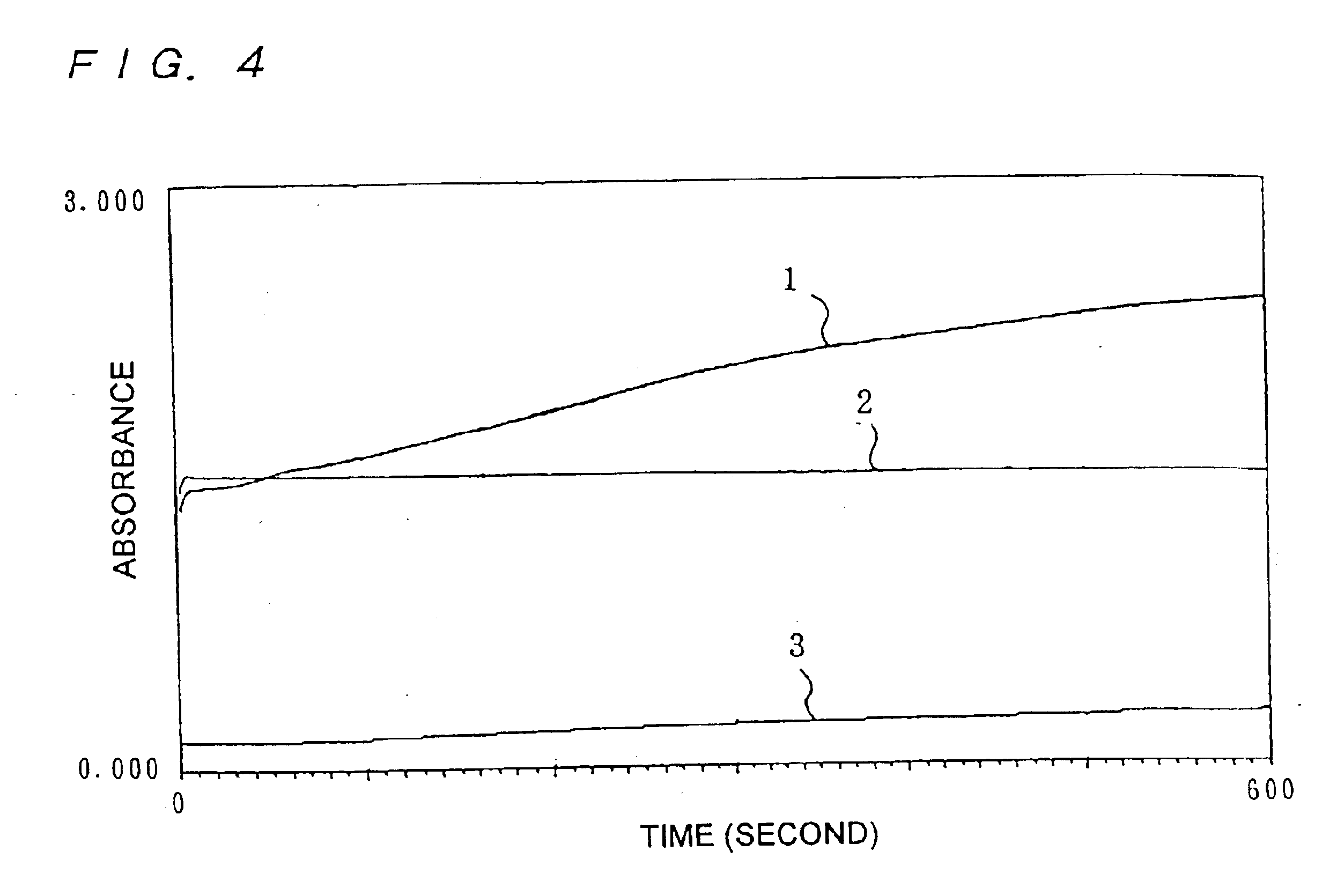Method for measuring substance and testing piece
- Summary
- Abstract
- Description
- Claims
- Application Information
AI Technical Summary
Benefits of technology
Problems solved by technology
Method used
Image
Examples
example 1
[0244]Peroxidase (POD), 4-AA and N-ethyl-N-(2-hydroxy-3-sulfopropyl)-3,5-dimethoxyaniline (to be abbreviated as EHSDA hereinafter) as dyestuff precursors, bis-tris buffer (pH 6.5) as a buffer, and smectite as a layered inorganic compound were taken to final concentrations shown in. Table 2, and hydrogen peroxide was added to these to a final concentration of 120 μmol / l and allowed to react to obtain a reaction solution. The absorption spectrum of an agglomerated portion of the obtained reaction solution was measured at a wavelength of 450 to 750 nm.
[0245]POD, 4-AA, EHSDA and a bis-tris buffer were taken to final concentrations shown in Table 3, and hydrogen peroxide was added to these to a final concentration of 120 μmol / l and allowed to react to obtain a reaction solution. The absorption spectrum of the obtained reaction solution was measured at a wavelength of 450 to 750 nm as well.
[0246]The measurement of absorbance was carried out using the JascoV-550 (Japan Spectroscopic Co. Lt...
example 2
[0252]POD, 4-AA, EHSDA and a bis-tris buffer (pH 6.5) were taken into a quartz cell having a cell length of 1 cm to final concentrations shown in Table 3 and incubated at 37° C. for 3 minutes. After the temperature was adjusted, hydrogen peroxide having a concentration shown in Table 5 was added to start a reaction and absorbance was measured 3 minutes after the start of the reaction. This reaction reached a termination completely 3 minutes after the measurement.
[0253]The instrument used was the JascoV-550 (Japan Spectroscopic Co. Ltd.), and the measurement wavelength was 593 nm (wavelength near the absorption maximum). A calibration curve of hydrogen peroxide when no smectite was added could be obtained from this result.
[0254]
TABLE 5Concentration ofhydrogenAbsorbanceperoxide (μmol / l)First timeSecond timeAverage2001.701.701.701000.850.850.85500.420.420.42250.210.210.21130.100.100.106.30.040.040.044.20.010.010.011.60.010.010.01
example 3
[0255]POD, 4-AA, EHSDA, a bis-tris buffer (pH 6.5) and synthetic smectite were taken into a disposable cell having a cell length of 1 cm (made from polymethyl methacrylate) to final concentrations shown in the above Table 2, and the temperature was adjusted to 37° C. for 180 seconds. After the temperature adjustment, hydrogen peroxide was added to a final concentration shown in Table 6, and absorbance was measured from 10 seconds after the addition of hydrogen peroxide for 1,800 seconds at intervals of 2 seconds. The JascoV-550 (Japan Spectroscopic Co. Ltd.) was used as a measuring device, and the measurement wavelength was 577 nm (wavelength near the maximum absorption wavelength). To measure only an agglomerated portion, a 0.1-ml slit was used. The measurement result at a hydrogen peroxide concentration of 0 μmol / l was made blank, the difference of absorbance (ΔAbs) from the blank at 1,800 seconds after the start of measurement was obtained, and a calibration curve of hydrogen per...
PUM
 Login to View More
Login to View More Abstract
Description
Claims
Application Information
 Login to View More
Login to View More - Generate Ideas
- Intellectual Property
- Life Sciences
- Materials
- Tech Scout
- Unparalleled Data Quality
- Higher Quality Content
- 60% Fewer Hallucinations
Browse by: Latest US Patents, China's latest patents, Technical Efficacy Thesaurus, Application Domain, Technology Topic, Popular Technical Reports.
© 2025 PatSnap. All rights reserved.Legal|Privacy policy|Modern Slavery Act Transparency Statement|Sitemap|About US| Contact US: help@patsnap.com



